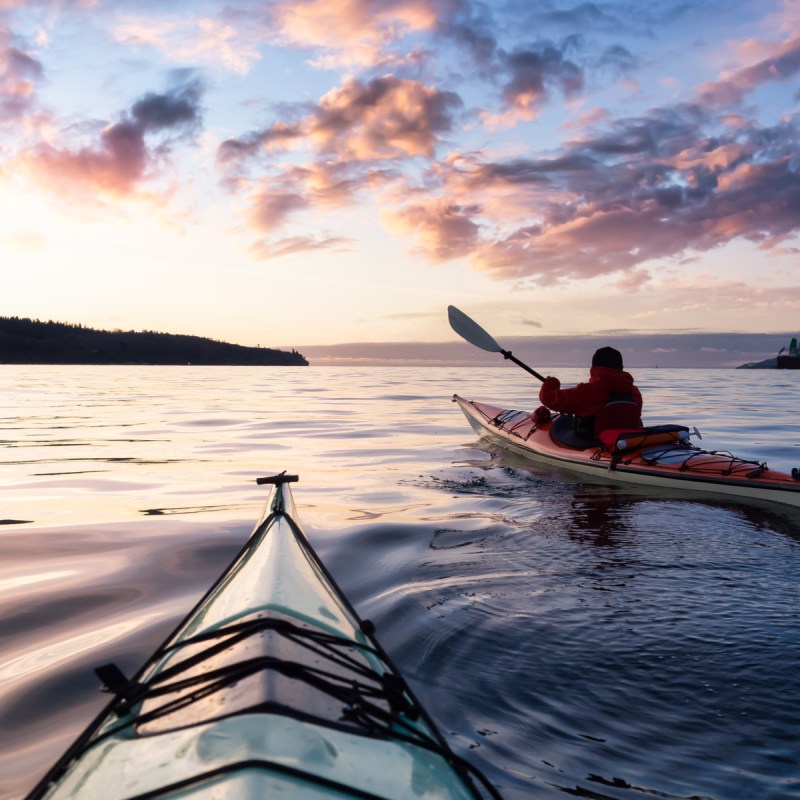
I had never been in a kayak that used a rudder and foot pedal system before.
Videos by TravelAwaits
In ocean kayaking, often sit-on-top kayaks are the way to go, and while I knew ocean kayaking would be vastly different from the lakes or rivers I’m used to, the idea of pressing foot pads to steer the kayak seemed strange.
The Azores is an archipelago composed of nine volcanic islands in the North Atlantic Ocean about 850 miles west of continental Portugal, and each island has its own personality and opportunities for kayaking.
In the early days of February, the Atlantic Ocean surrounding the Azores was still frigid, and the last thing we wanted to do was to take a plunge into that icy sea. When we visited Terceira Island, kayaking was one of the activities I couldn’t pass up. While Terceira specializes in ocean kayaking, the other islands in the Azores chain have volcanic-formed lakes and rivers to kayak on.
On Terceira, I was both nervous and excited to try watersports on this ocean that once hosted raging ship battles, traders’ ships heavy with spices from India, and Spanish invaders and pirates.
Heading to the Azores? Here are our picks for the best hotels in Sao Miguel Azores before your next trip.

Astonished In The Azores
The ocean off the coast of southern Terceira glimmered in the partly cloudy day, at times looking as smooth as a sheet of aluminum and other times undulating softly like a girl immersed in dance. Earlier in the week, we zipped across choppy waves while whale watching, so I knew the ocean wasn’t as calm as she seemed.
Still, I love kayaking. I adore sitting hip deep in water and gliding around like some sort of sea creature. I imagined settling into the kayak’s belly, letting the coordinated motion of the paddle propel me out somewhere into the Atlantic.
Instead, I had to shove my knees against the sides of the ocean kayak and position my feet to push paddles to help me turn. The system is surprisingly effective, but at the end of the four-hour adventure, my hips were screaming curses at me and begging for ibuprofen.
“Do we need to practice in the harbor?” our guide Sophie asked. Sophie was a French woman with a buttered croissant accent with more energy than her slim frame let on, and she was our guide with CommunicAir, the kayaking company we chose on Terceira.
She picked us up at our hotel in Angra do Heroismo to bring us to the harbor in neighboring Sao Mateus. The harbor town is a lively old fishing village where most of its residents still thrive on the fishing trade. The small, but important, fishing port is also home to the Museum of Angra do Heroismo, which includes information on the island’s whaling history.
We launched our sea kayaks and after a few clumsy attempts to steer the ruddered kayak, we seemed to get the hang of it and headed out onto the ocean.

A Leisurely Tour
The ocean wasn’t nearly as difficult to manage as I thought, and we steered our kayaks towards Monte Brasil, the large old volcano that protects the cove at Angra do Heroismo. After wobbling a few times on the gentle waves, I found a rhythm to my paddles and kept my knees pressed against the sides of the boat.
Monte Brasil rises from the Atlantic Ocean, connects to the main island of Terceira and is covered in thick forests. The last volcanic activity took place some 23,000 years ago, but the forest still shields the cove from the heavy oceanic winds, making Angra a highly sought-after port throughout history.
For several centuries, Monte Brasil’s fortress protected the town from pirates and other threats. It’s also home to one of the largest Spanish forts in existence outside of Spain, built after the conquest of Terceira by the Spanish military.
In fact, to this day, the old Spanish cannons still point inland, a reminder that although Terceira was invaded, it wasn’t defeated. The Portuguese eventually defeated the Spanish and reclaimed both their homeland and the fort itself.
Castelo de São João Baptista do Monte Brasil is a castle at the foot of Monte Brasil, built at the end of the 16th century on the order of Philip II of Spain who was also King of Portugal. Despite its impressive fortifications, the castle couldn’t stand against the Portuguese independence fighters, and in 1640, the fortress was surrendered.
Today, the Monte Brasil area still includes a military installation, but also hiking and walking trails that circle the entire volcano.
The sea remained calm as we pulled into a little cove for a break of hot, green tea and the famous Dona Amelia cakes. The Dona Amelia cakes, little muffins filled with spices, cinnamon and raisins, are also called “cake of the Indies,” and date back to 1901, at the time of the royal visit of Queen Amélia and King Carlos to Terceira Island. The islanders offered the cheesecakes to the king and queen as an acknowledgment gift, thus naming them Amélia, as a tribute to the queen.
We got back into the water and began the long paddle back to Sao Mateus where dreams of cold beer and a long stretch of the hips awaited.

Kayaking The Islands
Ocean kayaking is one option at the Azores, but on neighboring islands like Sao Miguel, deep cold lakes formed at the bottom of volcanic calderas make for perfect flatwater kayaking and canoeing.
In the center of Sao Miguel is Serra da Àgua de Pau, a mountain range reaching an altitude of 2,820 feet above sea level. Within this mountain range are the old craters of volcanoes that are now home to Sete Cidades, Fogo, and Furnas lakes. These mysterious mountain lakes sparkle with crystal-clear water with striking blue and green color, and swimming and water sports — as well as hiking, birdwatching, and photography — are some of the main tourist attractions.
The other seven islands of the Azores have their own lakes and coastline for kayaking as well. On the youngest island, Pico, kayaking and coastal exploring are popular with tours that provide sit-on-top kayaks with backrest and guided tours along the coastline of the island to the city of Pocinho’s bathing area and vineyard areas.

How To Go Kayaking In The Azores
Kayaking and canoeing in the Azores can be done in both inland waters and on the open sea. Several tour operators are available on the islands. Here are a few!
- Terceira: ComunicAir. ComunicAir has a team with experience organizing numerous outdoor events and initiatives like mountain biking, walking tours, kayaking, 4×4 tours and hot air ballooning tours.
- Sao Miguel: Futurismo. With 20 years of experience, Futurismo Azores Adventures is one of the largest active tourism companies in the Azores operating in four islands.
- Azores Adventure Islands This company offers a half-day kayaking tour on Sete Cidades and a half-day kayaking tour on Lake Furnas, both on Sao Miguel.
- Sao Jorge: Aventour. The Aventour is a touristic animation company, which operates in the adventure and nature tourism sector.
- Flores Island: Experience OC. This company rents out kayaks for adventures on Flores Island.
- Pico Island: Pico the Azores offers several kayaking tours around the coastline and swimming areas around Pico.
Watersports play an important part in most vacation plans, and kayaking is just one of the many activities that add excitement and adventure to a destination’s allure:
- Couple Kayaking: The Good, The Bad, And The Ugly
- Explore Florida’s Glowing Waters In A See-Through Kayak
- The Best Inflatable Kayaks In 2021
Find your haven! Discover and book your perfect place to rest among the hotels in São Miguel, Azores.
